Developing a successful product has never been a straightforward process, as there is no perfect formula to follow. The initial idea is just the starting point for understanding the market fit and product attributes, but the implementation presents the real challenge. The development phase is lengthy, and countless factors come into play, making it easy to get things wrong.
At the heart of this complex process lies the product manager, whose task is to ensure everyone is on the same page as the product idea evolves. A product roadmap is a strategic document that can help achieve this goal.
This article aims to define what is a product map, the product manager’s role in product development, the main features of a product roadmap, and how it can help teams stay aligned. It will also explore various types of roadmap and provide application roadmap examples and tips on creating one.
Product roadmap definition
A product roadmap is a strategic plan that outlines the direction of a product or service over time. It is a high-level document that provides a visual representation of a product’s future goals, features, and milestones. Product roadmaps are commonly used in product management to communicate a product strategy roadmap to internal teams, stakeholders, and customers.
A product roadmap typically includes the product’s vision, goals, and objectives, as well as a timeline for achieving these goals. It may also include information on market analysis, customer feedback, and the competitive landscape. The roadmap provides a framework for decision-making and helps teams stay aligned on the product’s direction.

While a product roadmap is a strategic document, it is not set in stone. It should be flexible and adaptable to changes in the market, customer needs, and internal priorities. Product roadmaps are often updated as new information becomes available or as the product evolves.
A strategic product roadmap is the result of deliberate planning that captures the executive product roadmap strategy and overall goals of a product. This type of roadmap typically includes the following key elements:
- Product vision: the future state of the product you aim to achieve.
- Strategy: a detailed execution plan that outlines how your company intends to realize the product vision.
- Goals: measurable, time-bound objectives that align with the product vision and support the overall product strategy roadmap.
- Initiatives: broad themes that group related features required to achieve a goal.
- Features: actual components of the product that contribute to its functionality or integrate with third-party applications.
- Timeframes: estimated dates or time periods for completing specific goals or features, with the understanding that they are subject to change.
- Status markers: indicators used to track progress and identify potential roadblocks.
- Metrics: data-driven goals and measurements, such as churn rate or organic traffic, that help to evaluate progress towards achieving the overall product vision.
Why are product roadmaps important?
As per the Product Excellence Report, a mere 41% of product professionals claim to effectively maintain their roadmaps. Having a robust plan in place can establish expectations and guarantee timely delivery.
A well-crafted product roadmap not only offers a broader perspective on the project but also identifies new opportunities and removes potential obstacles. It enables you to analyze your product development’s long-term growth and success.
The product development roadmap is the most authentic source of product vision and information by outlining the product goals, milestones, and activities aligning with the desired outcomes. The team’s daily work during development revolves around this roadmap, which is updated regularly in response to changing circumstances.
The product roadmap offers various benefits, including:
- Provides a strategic vision: The product roadmap helps to define a clear, strategic vision for the product. It outlines the long-term goals and objectives of the product, helping to align the team and stakeholders towards a common purpose.
- Enables better decision-making: The roadmap serves as a framework for making informed decisions about the product. It provides a visual representation of the product’s direction, allowing stakeholders to identify potential challenges and opportunities.
- Facilitates communication and collaboration: The roadmap helps to facilitate communication and collaboration between cross-functional teams, ensuring everyone is working towards the same goals. It helps to identify dependencies between teams and allows for better coordination of efforts.
- Helps to prioritize features: The roadmap assists in prioritizing features and requirements, ensuring that the most critical items are addressed first. This helps to ensure that resources are utilized effectively and that the product is developed in a way that meets the needs of the market and customers.
- Provides a timeline for delivery: The product roadmap helps to provide a timeline for the delivery of features and requirements. This helps to manage expectations and ensure that stakeholders know when they can expect certain features to be delivered.
- Helps to manage risks: The roadmap helps to identify potential risks and challenges associated with the product’s development. This allows the team to take steps to mitigate these risks and ensure that the product is developed in a way that minimizes potential issues.
Utilize Roadmap-Specific Tools
If you want to build a roadmap, using Excel can be a painful and static process. Luckily, cloud-based tools can speed up the process and keep your roadmap updated as priorities change. Here are a few options:
- OpenProject is a free roadmap tool allowing unlimited projects within a single user profile. It’s also tailored to the needs of Agile/Scrum teams and is an open-source product management software.
- Roadmap Planner is another open-source product management tool designed for Linux.
- ProductPlan is one of the most popular tools available, used by big names like Windows and Adobe. It offers a variety of roadmap templates for different purposes, and allows you to import items from Jira, spreadsheets, or VSTS to make the planning process easier.
- Aha! is another industry giant, used by companies like Shutterstock, LinkedIn, and Dell. It offers an impressive list of integrations with other applications.
- Roadmunk is also a top product management application that is affordable and meets necessary standards.
But to use all these tools efficiently, you need a professional responsible project manager.
Who is responsible for the product roadmap?
The number of teams involved in roadmapping may vary depending on the product being developed and the methodologies being used. Typically, teams such as engineering, UI/UX design, sales, marketing, support, project management, business analysis, development, and testing will be involved in product development. These teams will work together to bring the product to fruition.
The product manager plays a crucial role in leading the product development process. With a wealth of industry knowledge and a deep understanding of market trends, they define the definition of success for the product, identify consumer needs, align with corporate goals, and motivate the team to bring the product vision to life. Besides the product manager, these responsibilities can be handed to a business analytics specialist or project manager.
As part of their role, the product manager collects data, feedback, and user input through various means, including surveys, and prioritizes this information to develop strategies that are implemented to create the product roadmap.
To create an effective product roadmap, cross-functional collaboration is necessary. The product manager must ensure the participation and collaboration of team members to efficiently deliver the product and offer a complete product experience (CPE).
The product manager is responsible for
- conducting a thorough market analysis and competitive analysis
- setting deadlines for task completion and product development plans
- communicating the product’s vision to all relevant parties
- including management and customers
- providing ongoing communication channels with customers to develop the product’s idea, strategy, and methods between the production team levels to explain the strategy.
Process of creating a product roadmap
Following established and proven methods when approaching a complex process like creating a roadmap and what does a roadmap look like is wise. As such, here are some useful suggestions:
Formulate your strategy and vision of the product
Develop your product strategy and vision by consulting with both internal and external stakeholders, as well as customers, while also examining the market and competitors. Establish customer personas, pay attention to feedback from sales staff and customers themselves, and provide insights from customer perspectives to both the production team and management. Once all stakeholders and participants have a shared understanding of the vision, you can begin building your roadmap using the input data gathered.
Determine your audience
A product roadmap cannot be a universal plan that suits everyone. The audience you intend to present the roadmap to will determine the format, type, and content you need to include. Selecting the appropriate type of roadmap can be challenging, and we will elaborate on this in the next section.
Choose a suitable format
The format you choose will also have an impact on the content you select. The format you choose may be more appropriate for a specific audience. For example, a feature-based format may not be suitable for the marketing department or management but may be recommended for your engineering team. The format you choose will indicate which information needs to be emphasized and which themes or goals should take priority on the timeline.
Select and customize appropriate metrics
Metrics can provide a comprehensive view of progress and aid decision-making. Depending on the purpose of your product roadmap, metrics may be geared towards customer needs or business requirements. You can analyze the market and competition or seek guidance from industry analysts to obtain relevant metrics. To gain insight into the KPIs and metrics employed in Agile product development, refer to our informative article.
Utilize tools specifically designed for roadmapping
Building a roadmap using a tool such as Excel can be a tedious task. Additionally, a static presentation would be challenging to update as priorities change. Cloud-based roadmapping tools can expedite the process and facilitate updates to the roadmap.
Keep the information high-level and up to date
To ensure that your strategic roadmap remains functional, it is crucial to emphasize the overall vision and strategy rather than the tactics. While the details are valuable, the roadmap must be easy to comprehend and provide a clear strategic direction. Avoid being overly detailed or including irrelevant information.
The second point to consider is the ever-changing nature of your product roadmap. As your product evolves and new features and goals are added, it is important to continuously update the roadmap and communicate the changes to stakeholders. This process requires a gradual evolution of the roadmap alongside the product.

Types of product roadmaps
Product roadmaps can take different forms and structures depending on the type of data they convey and the logic they follow. Different types of product roadmaps can be tailored to meet specific needs. Brian Lawley’s book, “Expert Product Development,” offers a classification of general-purpose roadmaps, such as the strategy and market roadmap, visionary roadmap, software technology roadmap, technology across product roadmap, platform roadmap, and internal and external product roadmap.
Different types of product roadmaps are available to effectively convey the most relevant information based on the nature of the plan, strategies, and audience. Each roadmap type presents similar information in a slightly different way, often with varying levels of detail. It is essential to choose the roadmap type that best meets all of the plan’s requirements. Below are some product roadmap types that may be considered:
Portfolio Roadmap
A portfolio roadmap is designed to provide a strategic overview of the products that a company is planning to release, often from the perspective of leadership. It helps leaders better understand how various product teams collaborate and how their goals align with the company’s overall objectives. The portfolio roadmap displays upcoming releases for several goods in a single perspective, making it easy to see how all the products fit together and how they contribute to the company’s strategic goals. This type of roadmap is particularly useful for companies with multiple product lines or those looking to expand their offerings in new markets.
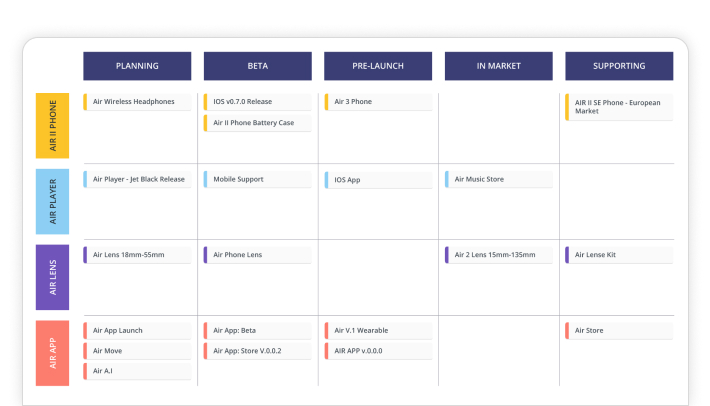
Feature Roadmap
A feature roadmap is a type of roadmap that displays the delivery schedule for new features and applications. It is an excellent tool for communicating information and telling potential customers and other stakeholders when and what is coming and how it can benefit them. This type of roadmap is particularly useful for product teams that are focused on developing new features or enhancing existing ones. By visualizing the features in a roadmap, teams can see how they fit together and contribute to the product’s overall value proposition.
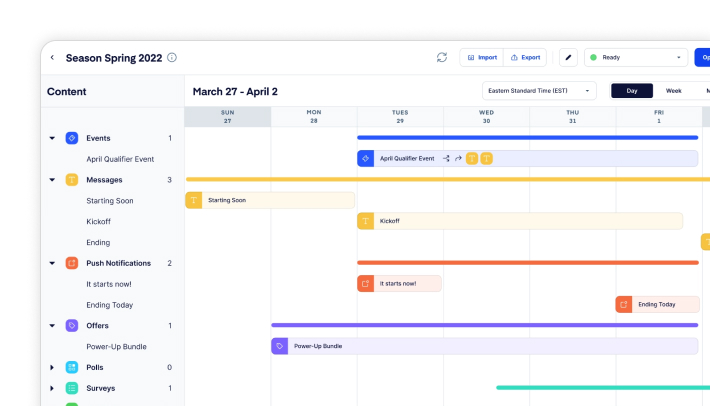
Epic Roadmaps
An epic roadmap is a type of roadmap that is essential for bringing together relevant components to help plan and organize upcoming tasks. It helps product teams set objectives, communicates key emphasis areas, and visualize work done across several releases. Epic roadmaps are particularly useful for large-scale projects requiring significant coordination across different teams and departments. By breaking down the project into smaller pieces and visualizing them in a roadmap, teams can better understand how their work contributes to the project’s overall success.

Strategy Roadmap
A strategy roadmap is a tool that helps product teams communicate their high-level plans and goals to stakeholders and leadership. It is useful for updating leadership on the status of initiatives and ensuring that cross-functional teams are aligned with the overall company strategy. The strategy roadmap helps to demonstrate the high-level efforts that the product team intends to undertake to fulfill the objectives of the product roadmap. It can also help to ensure that product development efforts are aligned with the company’s overall goals and vision.
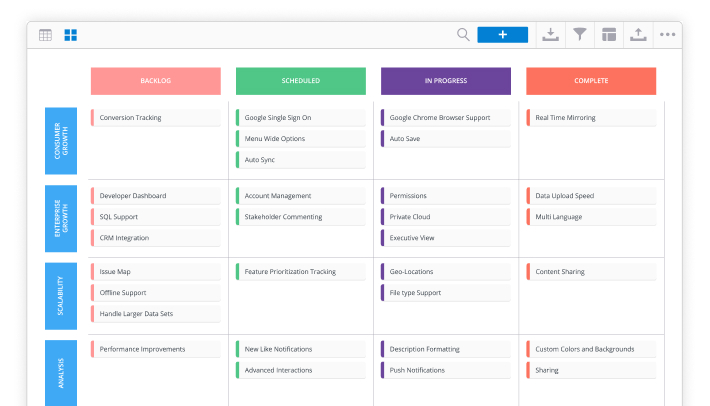
Release Roadmaps
A release roadmap is a type of roadmap that explains the steps that must be taken before a product can be released to the market. It includes when each step must be completed and who is responsible for delivery. Release roadmaps are valuable for synchronizing release operations with other cross-functional teams like sales, marketing, and customer support. By visualizing the steps in a roadmap, teams can see how each task contributes to the overall release plan and how they fit together to deliver the final product to the market.
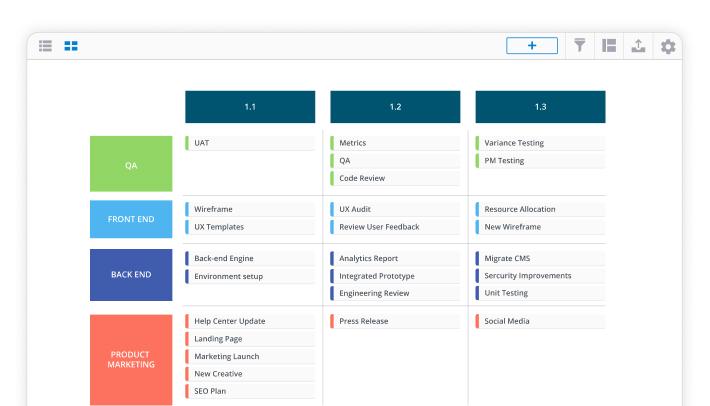
Product Roadmap Examples
A dynamic roadmap is preferable to static charts or spreadsheets since it promotes greater efficiency. It should also be automatically updated and promptly revised when changes or modifications occur to avoid future complications. The sample product roadmaps include:
Status-oriented
A status-oriented roadmap simplifies the understanding of the team’s current status without committing to a specific timeline. It has three columns based on the status of each deliverable – now, next, and later. This type of roadmap benefits prioritization and provides clarity on what the team is working on at any given time. Additionally, it allows for flexibility in shifting items between the next and later columns.
Theme-oriented
Theme-oriented roadmaps aim to communicate the value to be delivered to users without going into the specifics of what the team will deliver within that theme. This high-level approach is particularly useful for stakeholders and teams to align on the product direction and vision without getting bogged down in details.
By keeping the roadmap at this level, the team stays focused on solving the larger problem, and any new ideas or requests can be evaluated based on whether they fit into the theme of the current period. Theme-oriented roadmaps are usually structured around quarters, allowing the team to adapt and adjust to changing circumstances.
Outcome-oriented
The approach of an outcome-oriented roadmap is similar to a theme-oriented roadmap, but it differs in its focus on the highest level, which is an outcome. An outcome is the result or consequence of something. By agreeing on the outcomes that the team will work towards, it gives the team the power to define the solution.
Many roadmaps make the mistake of defining the solution before the problem. An outcome-oriented roadmap flips this on its head and allows for a healthier environment for the team while keeping stakeholders happy.
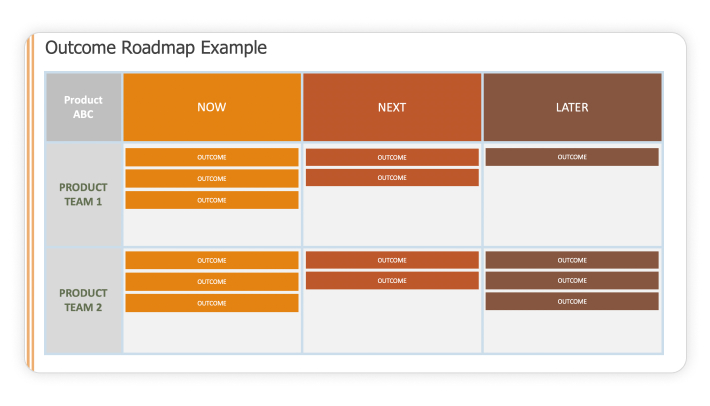
Goal-oriented
Another sample product roadmap is a goal-oriented product roadmap which focuses on organizing and explaining all the information by setting goals for each feature. It uses simple phrases like “increase user engagement” or “speed up the registration process” to describe the goals. Structuring the content around the goals can help you maintain a clear policy and vision.
Now-next-later roadmap
The now-next-later roadmap is a simplified representation of the product backlog that categorizes tasks, sprints, and features in a prioritized manner. This type of roadmap displays information horizontally and vertically and illustrates what will be released presently, what is planned for the next phase, and what will be released at a later time. The primary objective of this roadmap is to present priorities in the most straightforward manner possible.

Feature-based
A feature-based product roadmap uses a feature as the main focus to provide a robust schedule for providing members with additional details and serving potential consumers at a greater scale. It’s also useful for conveying specific information, such as the status of particular features or product application.
IT product roadmap
IT product roadmaps are basic documents used to support the primary strategic product development roadmap. The internal teams use such templates to develop and streamline technical needs. Software technology roadmaps aid with resource allocation and specify how a certain technology will be used, as well as define how it will benefit the users eventually.
Strategy roadmap
A product roadmap strategy is a general-purpose product development roadmap template that can contain any information and can be tailored to diverse audiences. It provides an elite-level overview of extensive product information connected to a certain aspect, depending on the short or long-term objectives.
Conclusion
After reading all of the information about product roadmaps, you may wonder whether investing the time and resources to create one is necessary. Building a product roadmap is indeed a significant undertaking that requires effort from the product manager to gather input from stakeholders and the product team.
However, if maintained and formatted correctly, a roadmap can be valuable, providing teams with easy access to strategic information. Ultimately, if a roadmap can help you achieve your production goals, it is worth creating.
On the other hand, if building and distributing a roadmap takes too much time, or if its maintenance requires constant updating of multiple documents, then it may not be the best approach for your team.
If you find it challenging to prioritize tasks and set strict deadlines, there are alternative product management techniques you can consider, such as user story mapping or general backlog prioritization techniques used in Agile development. In the end, products are driven by the backlog in one way or another, so finding a method that works best for your team’s needs is essential.


















